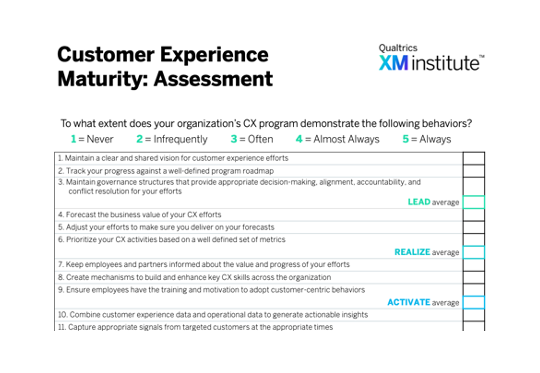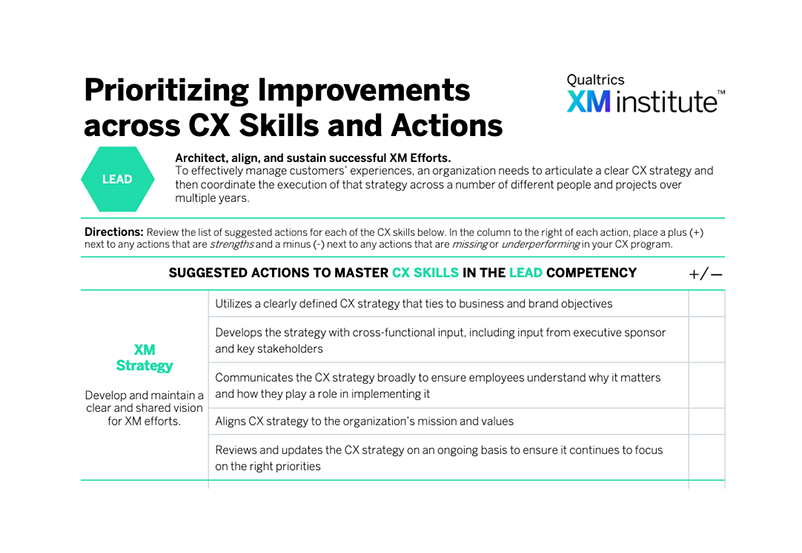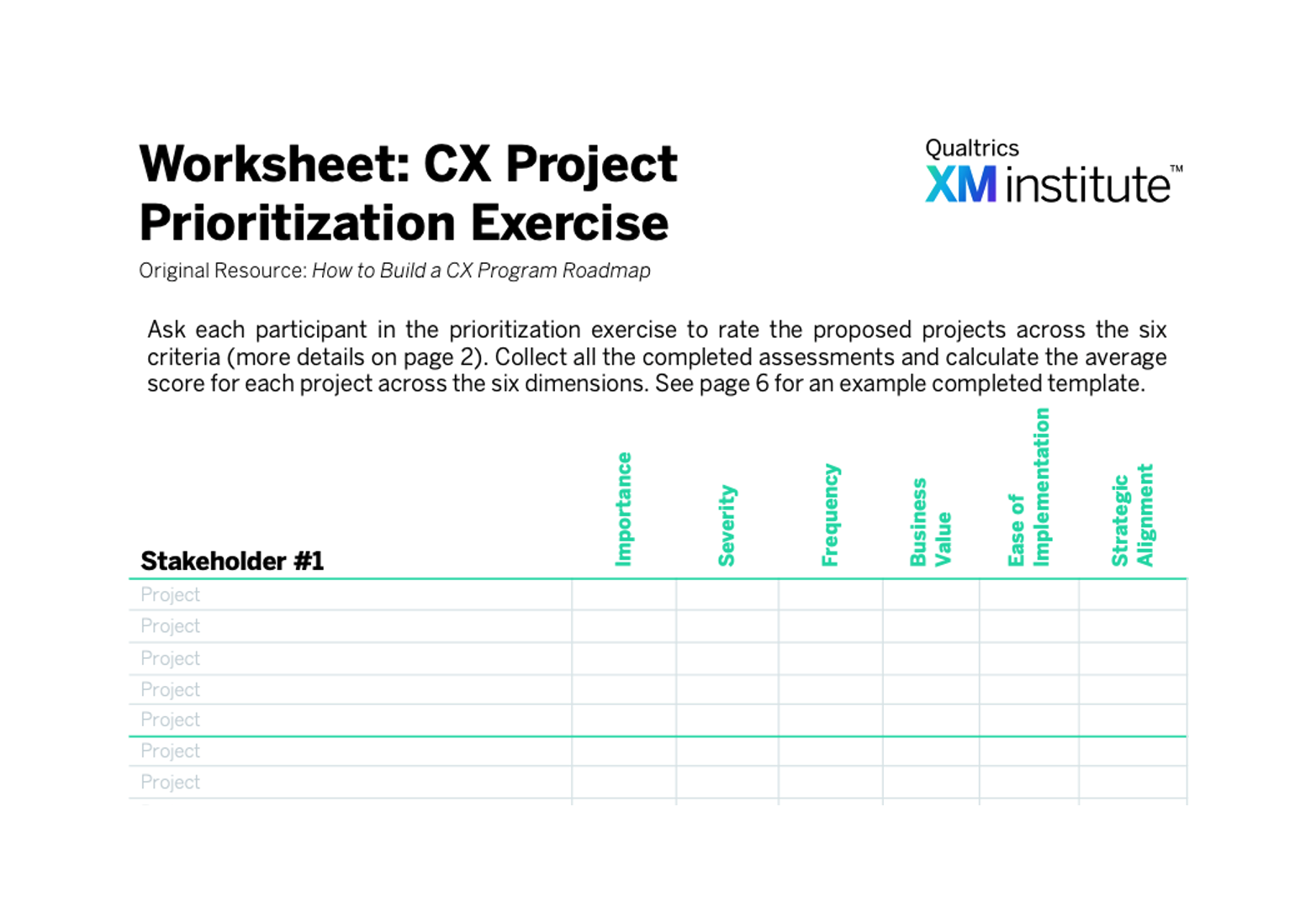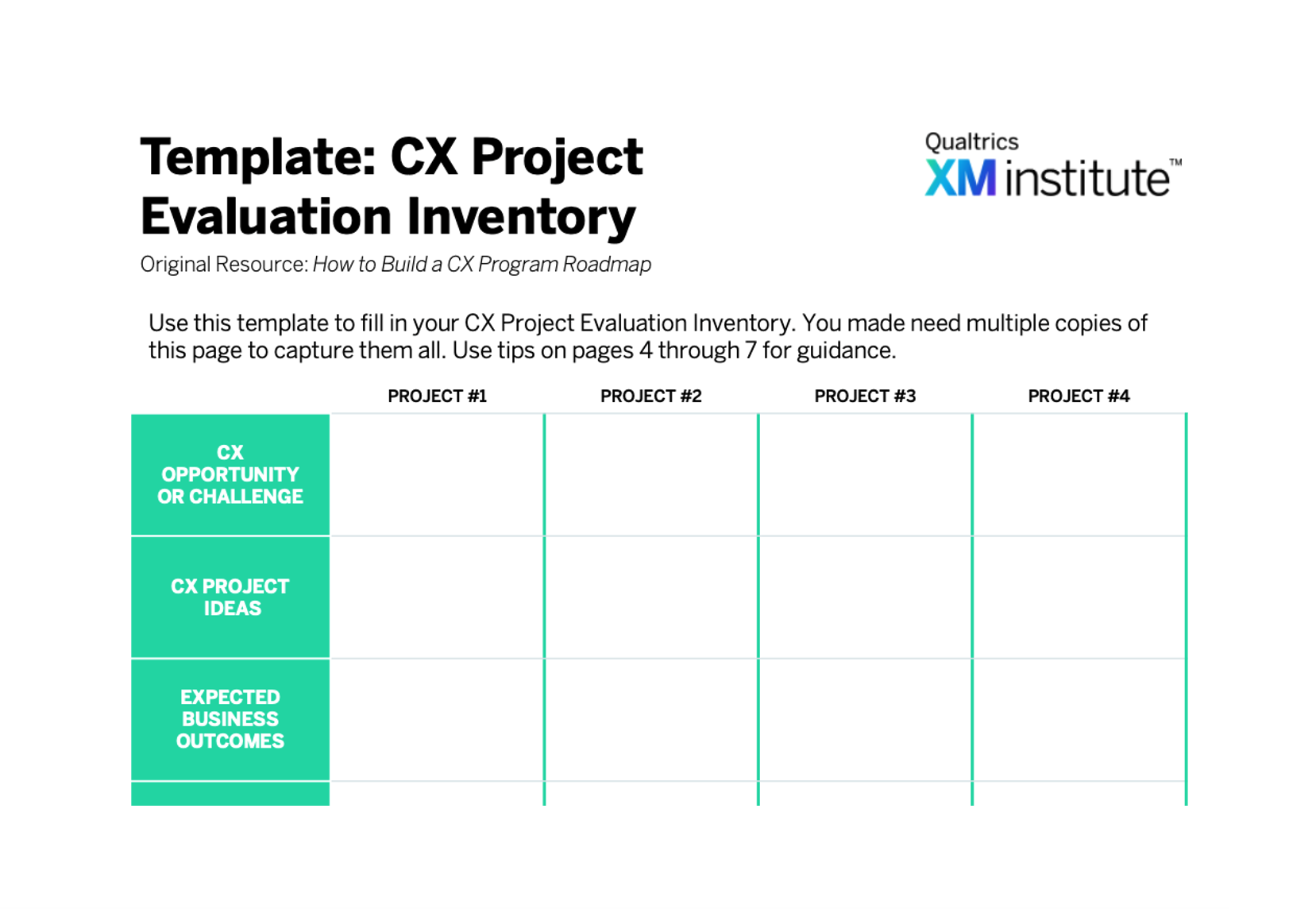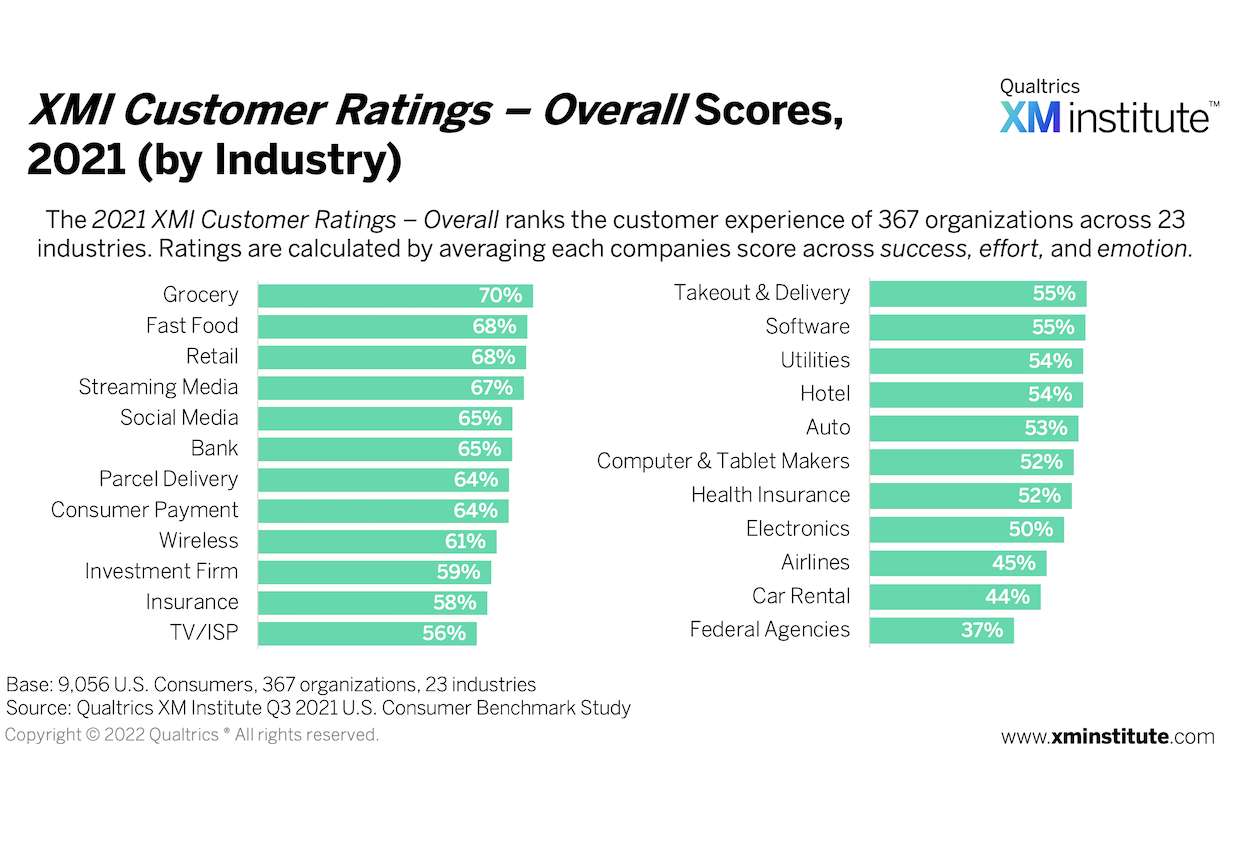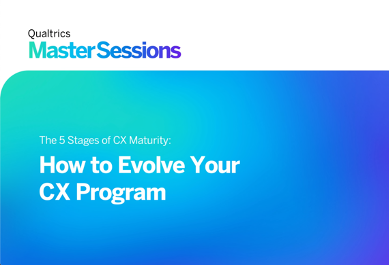Use this Launchpad as a starting place to understand what customer experience (CX) management is, why it’s important, and how you can start building your organization’s CX management capabilities. Then, explore the key resources included at the bottom of the page to expand your CX knowledge.
The Fundamentals
Customer experience (CX) is defined as:
The perception customers have of their interactions with an organization
The word “perceptions” here is critical. Experiences are in the eye of the beholder, which means that these perceptions – whether they are positive or negative – are going to impact customers’ future behaviors towards the business, like whether they purchase more products or recommend the company to others. That’s why companies with more mature CX management programs, who are consistently able to meet or exceed customer expectations, also enjoy stronger financial results than their less mature peers.
Customer experience is not the responsibility of the CX team alone. It’s also not the sole responsibility of frontline employees in sales, service, and support. All employees across an organization play a role in the quality of customers’ experience – even employees from departments like legal or communications who never interact directly with a customer.
CX management is part of the larger discipline of Experience Management (XM). To master CX management, companies should adopt the XM Operating Framework, which is built on a combination of Technology, Culture, and six Competencies. While each of these three elements is important, organizations should focus most of their attention on these six Competencies and their 20 associated Skills.
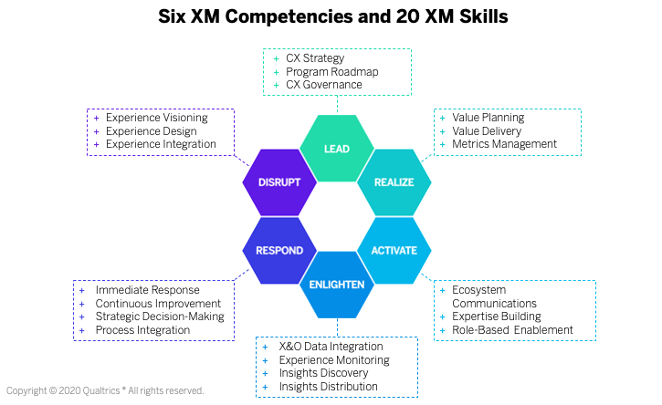
Lead
Effective CX management requires an organization to articulate a clear CX strategy and then coordinate the execution of that strategy across a number of different people and projects over multiple years. This Competency is about architecting, aligning, and sustaining successful CX efforts, and the Skills associated with it are CX Strategy, Program Roadmap, and CX Governance.
Realize
For CX efforts to have a lasting positive impact, they generate strategic and financial value for the organization. This Competency is about identifying and tracking the right metrics to ensure CX efforts achieve well-defined business objectives, and the Skills associated with it are Value Planning, Value Delivery, and Metrics Management.
Activate
People tend to gravitate towards the status quo, so a successful CX program must overcome people’s inertia and their natural resistance to change. This Competency is about making sure that the organization has the appropriate skills, support, and motivation to achieve desired CX results, and the Skills associated with it are Ecosystem Communications, Expertise Building, and Role-Based Enablement.
Enlighten
To improve the customer experiences it delivers, an organization must be capable of collecting and processing a constant flow of experience and operational data and then transforming it into useful information. This Competency is about capturing, analyzing, and distributing actionable insights, and the Skills associated with it are X&O Data Integration, Experience Monitoring, Insights Discovery, and Insights Distribution.
Respond
Gathering and disseminating insights is all well and good, but ultimately, value is only generated when an organization acts on what it learns. This Competency is about building organizational mechanisms to continuously take action based on insights, and the Skills associated with it are Immediate Response, Continuous Improvement, Strategic Decision-Making, and Process Integration.
Disrupt
While finding and fixing problems is necessary, just responding to explicit issues is not sufficient to capture customers’ hearts and minds. This Competency is about identifying and creating experiences that differentiate the organization from its competitors, and the Skills associated with it are Experience Visioning, Experience Design, and Experience Integration.
Listening Elements of a CX Program
CX programs often contain a portfolio of customer listening elements, which include:
Relationship tracking
These are periodic studies to understand customers’ attitudes towards an organization, and they often provide the input for core CX metrics like Net Promoter Score or overall satisfaction. The insights from a relationship study often drive the overall priorities for a CX program.
Journey feedback
This type of listening identifies customer perceptions after they’ve completed a specific goal, such as getting customer service support or purchasing a product. Journey feedback can come from multiple sources, including surveys, social media listening, and always-on digital mechanisms.
Interaction feedback
This area of listening is used to monitor and improve specific customer touchpoints, such as making a call into a contact center or reserving a flight online. Interaction feedback helps companies understand how customers perceive experiences through three lenses: success (were they able to do what they wanted to do?), effort (how easy or hard it was to do?), and emotion (how it makes the customer feel?).
Always-on listening
Customer feedback doesn’t always need to be actively solicited. It’s also important to provide customers with the opportunity to provide feedback whenever and however they’d like. Always-on listening is often handled by offering digital collection mechanisms on your websites and mobile apps. These mechanisms tend to use more open-ended elements to allow for a wide range of feedback.
Passive listening
This type of listening is based on collecting and analyzing existing customer signals in the marketplace. These unsolicited customer insights come from areas such as customer care interactions and social media posts.
Tips for Taking Action
How can an organization successfully adopt the business discipline of CX management? Here are a few key elements for success:
Chart your maturity roadmap
Use the XM Institute’s CX Maturity Assessment to identify your organization’s strengths and weaknesses across the six XM Competencies. Then, build a roadmap to navigate the five stages of CX maturity. Repeat the Assessment every 6-12 months to identify key areas of focus.
Make the business case
Although research shows that CX correlates to customer loyalty, CX groups often need to justify CX spending. Start by identifying which loyalty behaviors you’re trying to improve and then build models to show how you expect those behaviors to drive changes in key CX metrics. To secure buy-in, involve the CFO’s team, use existing metrics and conservative estimates, and communicate results with a simple storyline.
Focus on improvements; not measurements
When companies obsess over a metric rather than using the score to drive improvements, their progress toward CX maturity can stall. To avoid that – and keep the focus on CX improvements and resulting business outcomes – leaders should always ask two questions whenever their team presents CX metrics: “What have we learned?” and “What improvements are we making?”
Drive CX change, but don’t own CX
Since CX is everyone’s business, CX teams won’t succeed unless they infuse new behaviors across the organization. They can’t let themselves be positioned as “owning CX,” but rather they need to be seen as enabling other groups to change, That’s why CX teams need to focus on equipping departments and teams – even leadership – with the appropriate skills and motivation to deliver better experiences.
Listen to and focus on your employees
Just about every successful CX program includes at least some aspects of an employee experience (EX) program. That’s because CX and EX are inextricably linked. At a minimum, CX efforts should tap into the voice of employees, as they can often shine a light on problems and opportunities faster and with more depth than what you find in customer feedback.
Start by making (and sharing) quick wins
Organizations in the early stages of CX maturity should focus on demonstrating CX value through quick wins in order to secure senior executive buy-in and resources. Set up simple listening posts, look for evidence of broken customer journeys, focus on the problems that are quickest and easiest to fix, and share stories about how the changes helped customers and improved business metrics.








